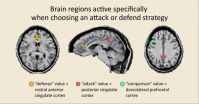INFORMATION:
Funding for this study was provided in part by the Health Resources and Services Administration under grant award numbers HP10251 and T32 HP12706; the Ryoichi Sasakawa Fellowship Fund; and the Harvard Pilgrim Health Care Institute. END
Reduction in opioid prescribing, overdoses associated with pharma industry changes
2015-04-20
(Press-News.org) (Boston) - Results of a new study led by Boston Medical Center (BMC) researchers, in collaboration with Harvard Medical School (HMS), indicate that the introduction of abuse-deterrent OxyContin, coupled with the removal of propoxyphene from the US prescription marketplace, may have played a role in decreasing opioid prescribing and overdoses. The findings, published in JAMA Internal Medicine, showed that these two changes led to a 19 percent drop in prescription opioid supply that was mirrored by a 20 percent drop in prescription opioid overdose between August 2010 and December 2012. The drop in prescription opioid overdose was partially offset by an increase in overdose due to heroin, an illicit opioid.
The number of overdose deaths from prescription opioid abuse quadrupled in the US between 1999 and 2010; and sales of prescription opioids skyrocketed during that same timeframe. National data has shown that areas with higher prescription opioid rates have higher overdose rates. Opioid related overdose deaths have exceeded the number of motor vehicle deaths each year since 2005 in Massachusetts and are the leading cause of injury death in the commonwealth.
"The number of people dying from opioid overdoses indicates the urgency with which we need to deal with this crisis, which is one of the leading public health issues of our time," said Marc Larochelle, MD, MPH, research scientist and physician at BMC who began this work while a general internal medicine fellow at HMS.
The pharmaceutical industry has developed formulations designed to reduce misuse of opioid medications, including making pills resistant to crushing and dissolving. The US Food and Drug Administration (FDA) approved an abuse-deterrent form of OxyContin that was made available by prescription in August 2010. In addition, the drug propoxyphene, which was approved by the FDA in1957 to treat pain but was shown to have high rates of overdose deaths and cardiac side effects, was pulled from the market in November 2010.
Researchers examined claims from a large US commercial health insurer of 31.3 million members between the ages of 18 and 64 for the time period between January 2003 and December 2012.
OxyContin prescribing dropped by 39 percent in the two years after the formulation change. There was no evidence that people switched to alternative extended-release prescription pain medications, nor did the cost of OxyContin rise for consumers during the study period. "These results suggest that many people who were prescribed OxyContin before it was reformulated may have been diverting or misusing the drug," said Larochelle.
"Given the decreased supply of prescription opioids, those seeking out an opioid could be turning to heroin, which may partially explain the tremendous increase in heroin overdose deaths over the past few years both locally and nationally," said Larochelle, also an assistant professor of medicine at Boston University School of Medicine. "Our results indicate the potential of pharmaceutical changes in helping combat the opioid epidemic, but we stress the need for complementary interventions targeting the identification and treatment of addiction to curb opioid abuse."
ELSE PRESS RELEASES FROM THIS DATE:
Global pandemic of fake medicines poses urgent risk, scientists say
2015-04-20
Poor quality medicines are a real and urgent threat that could undermine decades of successful efforts to combat HIV/AIDS, malaria and tuberculosis, according to the editors of a collection of journal articles published today. Scientists report up to 41 percent of specimens failed to meet quality standards in global studies of about 17,000 drug samples. Among the collection is an article describing the discovery of falsified and substandard malaria drugs that caused an estimated 122,350 deaths in African children in 2013. Other studies identified poor quality antibiotics, ...
New pathway reveals how immune system is regulated; gives hope for chronic diseases
2015-04-20
Researchers from the University of Birmingham have identified an important new way in which our immune systems are regulated, and hope that understanding it will help tackle the debilitating effects of type 1 diabetes, rheumatoid arthritis and other serious diseases.
The team discovered a novel pathway that regulates the movement of pathogenic immune cells from the blood into tissue during an inflammatory response.
A healthy, efficient immune system ordinarily works to damp down inflammation and carefully regulate the magnitude of the response to infection and disease. ...
Genetic road map may bring about better cotton crops
2015-04-20
A University of Texas at Austin scientist, working with an international research team, has developed the most precise sequence map yet of U.S. cotton and will soon create an even more detailed map for navigating the complex cotton genome. The finding may help lead to an inexpensive version of American cotton that rivals the quality of luxurious Egyptian cotton and helps develop crops that use less water and fewer pesticides for a cotton that is easier on the skin and easier on the land.
Z. Jeffrey Chen and his collaborators, Tianzhen Zhang and Wangzhen Guo at Nanjing ...
Childhood syndrome combining lung disease, arthritis is identified
2015-04-20
Using the latest genome sequencing techniques, a research team led by scientists from UC San Francisco (UCSF), Baylor College of Medicine, and Texas Children's Hospital has identified a new autoimmune syndrome characterized by a combination of severe lung disease and arthritis that currently has no therapy.
The hereditary disorder, which appears in early childhood, had never been diagnosed as a single syndrome. The new research revealed that it is caused by mutations in a single gene that disrupt how proteins are shuttled around within cells. Patients with the newly ...
A 'cingular' strategy for attack and defense
2015-04-20
We often make quick strategic decisions to attack an opponent or defend our position, yet how we make them is not well understood. Now, researchers at the RIKEN Brain Science Institute in Japan have pinpointed specific brain regions related to this process by examining neural activity in people playing shogi, a Japanese form of chess. Published in Nature Neuroscience, the study shows that two different regions within the cingulate cortex--one toward the front of the brain and the other toward the back--separately encode the values of defensive and offensive strategies.
Like ...
Ocean currents impact methane consumption
2015-04-20
Large amounts of methane - whether as free gas or as solid gas hydrates - can be found in the sea floor along the ocean shores. When the hydrates dissolve or when the gas finds pathways in the sea floor to ascend, the methane can be released into the water and rise to the surface. Once emitted into the atmosphere, it acts as a very potent greenhouse gas twenty times stronger than carbon dioxide. Fortunately, marine bacteria exist that consume part of the methane before it reaches the water surface. Geomicrobiologists and oceanographers from Switzerland, Germany, Great Britain ...
Science of learning can help parents, developers grade educational apps
2015-04-20
New apps developed for children come online every day and many of them are marketed or labeled as "educational" - but how can we tell which of these thousands of apps will actually help children learn? A comprehensive new report published in Psychological Science in the Public Interest, a journal of the Association for Psychological Science, integrates research from scientific disciplines like psychological science, linguistics, and neuroscience to provide an evidence-based guide that parents, educators, and app designers alike can use to evaluate the quality of so-called ...
As US assumes Arctic Council chairmanship, new report emphasizes cooperation over conflict
2015-04-20
HANOVER, N.H. - Although the media often portray the Arctic as a new "Great Game" ripe for conflict, a group of international Arctic experts co-chaired by Dartmouth College released recommendations today aimed at preserving the polar north as an area for political and military cooperation, sustainable development and scientific research.
The report, which addresses the priorities of the Arctic Council, an intergovernmental forum of the eight nations that border the polar region, resulted from meetings at the Carnegie Endowment for International Peace in Washington, ...
Down to 3 wolves on Isle Royale
2015-04-20
Only three wolves seem to remain in Isle Royale National Park. Researchers from Michigan Technological University observed the wolves during their annual Winter Study, and the lone group, at an unprecedented low, is a sharp decline from nine wolves observed last winter.
The study's report, released today, marks the project's 57th year of observing wolves and moose in Isle Royale. It is the longest running predator-prey study in the world. This year, along with the three resident wolves, scientists estimated 1,250 moose on the island and observed two visiting wolves, ...
Decreased red blood cell clearance predicts development and worsening of serious diseases
2015-04-20
Massachusetts General Hospital (MGH) investigators have found the probable mechanism underlying a previously described biomarker associated with the risk of developing serious diseases ranging from cancer to cardiovascular disease and the risk of serious complications. In a paper published in the American Journal of Hematology, the research team reports finding that higher levels of a measure routinely taken as part of the complete blood count - the extent of variation in the size of red blood cells - is caused by reduced clearance of aging cells from the bloodstream. Hundreds ...


